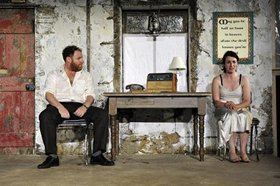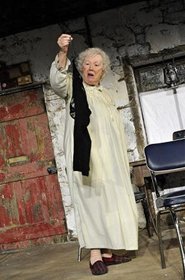When Martin McDonagh’s Leenane plays first appeared in Ireland, they seemed exciting for many reasons: their delinquent humour, their rootedness in (but distance from) the Irish dramatic tradition, their wilfully transgressive attitude – and, in particular, their disorientating blend of the past with the present. The environment that McDonagh presented seemed like a skewed representation of 1950s Ireland: eternally rain-filled and poteen-soaked, his Leenane was populated by an over-familiar rabble of frustrated spinsters, lonely priests, ape-like peasants, and kind-hearted but feisty colleens. Yet the language that those characters used was firmly rooted in the 1990s, with references to Packie Bonner’s performance in the 1994 World Cup, the wars in Bosnia, Bishop Eamon Casey, and so on. Many academic critics have suggested that McDonagh’s plays allowed audiences (especially in Dublin) to laugh at an imagined version of our rural past – to reassure themselves that we had left that old Ireland behind. But, watching those plays travel around Ireland between 1996 and 2001, I always felt that McDonagh was doing something far more challenging. His inclusion of those topical references tended to disrupt our sense of distance from the past: he seemed to be suggesting that we can’t ever forget where we came from, much as we might like to pretend otherwise.
The problem, however, is that this blend of the past and present has had the strange impact of making The Leenane Trilogy seem prematurely dated, at least in Ireland. The references to 1990s pop culture often go unrecognised by younger members of the audience, and will only dimly be recalled by everyone else (anyone remember A Country Practice?). The jokes about clerical child abuse and about the Troubles in Northern Ireland have lost most of their transgressive power. And McDonagh has so often been imitated (and has so often repeated the same tricks in his own plays) that we’re less likely to be shocked by his use of violence, and less likely to be surprised by the twists and turns in his plots.
 One of the most admirable features of this Young Vic revival of The Beauty Queen of Leenane is that it finds a way of making the play seem fresh again. Curiously, it does so not by offering us a new perspective on the play, but instead by producing it with utter fidelity – as a kind of history play, a recognised classic that can bypass temporal or geographical barriers. In short, it makes McDonagh seem new by treating his work as if it’s been around for much longer than 14 years.
One of the most admirable features of this Young Vic revival of The Beauty Queen of Leenane is that it finds a way of making the play seem fresh again. Curiously, it does so not by offering us a new perspective on the play, but instead by producing it with utter fidelity – as a kind of history play, a recognised classic that can bypass temporal or geographical barriers. In short, it makes McDonagh seem new by treating his work as if it’s been around for much longer than 14 years.
This approach is evident from the beginning, in the entirely faithful set design, which reproduces exactly McDonagh’s stage directions – right down to the raindrops falling down the back window. Every line in the script is delivered exactly as it was written; every stage direction is perfectly observed. And the Young Vic has assembled a dream cast, pitting Susan Lynch and Rosaleen Linehan against each other as Maureen (the titular Beauty Queen) and Mag, her mother.
Lynch and Linehan are brilliantly matched, with both providing finely nuanced and complex characterisations: we can see the afterglow of the affection that both women once had for each other, but we also understand their mutual antagonism. We can see too the resemblances between mother and daughter, but also understand why Lynch’s character deserves a freedom that her mother could never even imagine.
The performances by both women succeed because of the careful balancing of contrasting gestures and movements. At the start of the play, Lynch arrives on stage almost entirely covered by a raincoat; she’s slouching so much that we can almost feel her sense of being oppressed by her environment. As her relationship with the returned builder Pato Dooley develops, her body becomes both freer and more expressive. It thus becomes possible for us to understand how she could once have been considered a ‘beauty queen’ – but we understand too how she instead became a 40-year-old virgin.
 Similarly, Linehan gives a finely balanced and surprisingly restrained performance as Mag – a character who has too often been reduced to the status of pantomime villain in previous productions. Linehan’s gestures are small and often hesitant, allowing us to understand Mag’s vulnerability and her fear of being left alone – but that restraint means that when she needs to act decisively (by burning letters to her daughter, for instance), her actions seem all the more vivid, and all the more desperate. That vulnerability also intensifies the audience’s sense of shock when Mag is attacked by her daughter: the ease with which Maureen overpowers her mother shows how frail Mag actually is.
Similarly, Linehan gives a finely balanced and surprisingly restrained performance as Mag – a character who has too often been reduced to the status of pantomime villain in previous productions. Linehan’s gestures are small and often hesitant, allowing us to understand Mag’s vulnerability and her fear of being left alone – but that restraint means that when she needs to act decisively (by burning letters to her daughter, for instance), her actions seem all the more vivid, and all the more desperate. That vulnerability also intensifies the audience’s sense of shock when Mag is attacked by her daughter: the ease with which Maureen overpowers her mother shows how frail Mag actually is.
These performances are complemented by a superbly charismatic turn by David Ganly in the role of Pato. Again, the success of the characterisation lies in the actor’s willingness to create contrasts. On the one hand, we understand that Pato has the physical strength of any Irish builder: he moves as if used to carrying heavy weights, as if he’s certain that he’s not going to have his way blocked by anyone. Yet we also constantly sense his fragility: the body language Ganly uses when his character is trying to describe his emotions is always awkward and uncertain, revealing with a simple clarity Pato’s isolation and loneliness.
Perhaps the strongest moment in the production comes in its final moments. The last scene of The Beauty Queen has often been staged like an Irish Doll’s House, with Maureen strolling off stage clutching a suitcase. I’ve seen productions of the play that suggest that she’s leaving Leenane for good (rather like Ibsen’s Nora), while others (in keeping with the script) aim for ambiguity. Yet here the direction by Joe Hill-Gibbins makes absolutely clear that Maureen will never leave Leenane, that she has lost all hope, that she is doomed to become just like her mother. It’s a poignant but unsentimental conclusion – and one that’s fully earned, thanks to the conviction and intensity of the performances during the play.
So the reason this production works so well is that everyone involved obviously believes in the script: the gestures and lines are performed without exaggeration, its emotional elements are finely balanced, and although we never forget we’re watching an old-fashioned melodrama, the actors take their roles absolutely seriously. The company therefore does something that almost no one attempts anymore: they perform the play exactly as McDonagh wrote it. By doing so, they present an excellent production – one that reveals with clarity and force that there’s still life left in The Leenane Trilogy.
Patrick Lonergan teaches at NUI Galway. His student edition of Martin McDonagh’s The Lonesome West is being published this month by Methuen Drama.